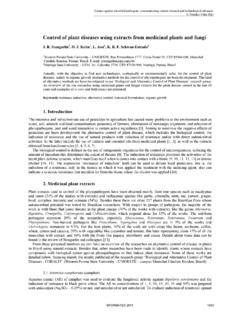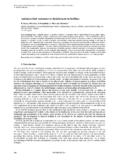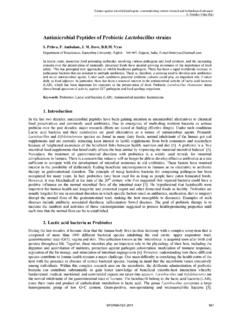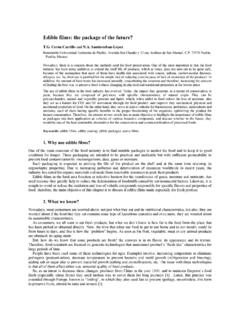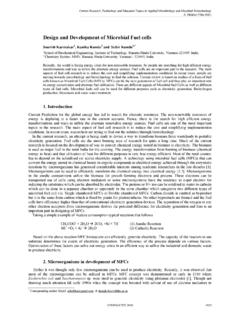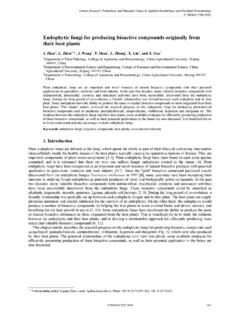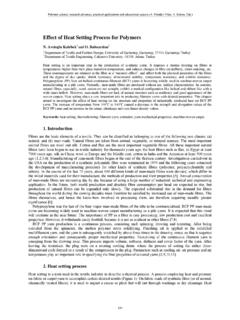Transcription of Biocompatibility of Dental Polymers - Formatex
1 polymer science: research advances, practical applications and educational aspects (A. M ndez-Vilas; A. Solano, Eds.). _____. Biocompatibility of Dental Polymers Oguzhan Yildiz, Melik Seyrek and Kemal Gokhan Ulusoy Department of Medical Pharmacology, Gulhane School of Medicine, 06018 Ankara, Turkey The use of Polymers has revolutionized the biomedical industry ever since their discovery. Dental Polymers , commonly known as Dental Resins, were first used in dentistry in 1839, and since then they are widely used especially in restorative dentistry for both cosmetic and functional purposes. A variety of different polymer materials vinyl acrylics, epoxy resins, polyether, polysulfide, silicone, polycarbonates, polyacrylic acid, polystyrene, polyethylene, polyvinyl acetate are used in dentistry. Typical applications of Polymers in dentistry are impression materials, relining materials, temporary crown materials, denture base materials, obturation materials (endodontic treatment), and filling materials (composites, cements, adhesives).
2 Many prostheses and implants made from Polymers have been in use for the last three decades and there is a continuous search for more biologically inert and stronger polymer Dental materials. Biocompatibility of Dental Polymers is an important clinical issue. The Dental Polymers that is to be used in the oral cavity should be harmless to all oral tissues gingiva, mucosa, pulp, and bone. Furthermore, it should contain no toxic, leachable, or diffusible substance that can be absorbed into the circulatory system, causing systemic toxic responses, including teratogenic or carcinogenic effects. The material also should be free of agents that could elicit sensitization or an allergic response in a sensitized patient. Rarely, unintended side effects of Dental Polymers may occur as a result of toxic, irritative, or allergic reactions. These reactions may be local and/or systemic. Local reactions involve the gingiva, mucosal tissues, pulp, and hard tooth tissues, including excessive wear on opposing teeth from restorative materials.
3 Systemic reactions are expressed generally as allergic skin reactions. The quantity of unconverted resinous monomers that remain after polymerization determines the cytotoxic effects of polymeric Dental materials, such as light-cured methacrylate Polymers . These monomers may alter the lipid layer of the cell membrane, which affects membrane permeability. They may also undergo hydrolysis, producing a water-soluble cytotoxic substance, methacrylic acid. Some monomers may also displace water in dentin and they are capable of diffusing rapidly through the dentin. Furthermore, they may reduce the rate of cellular proliferation and result in apoptosis, possibly as a response to DNA damage. Additionally, because the oral cavity is highly vascularized, the effect of Dental Polymers on vascular function can be relevant to clinical practice. Several experimental studies provided evidence for the marked vasodilating effect of Dental Polymers , which might impair pulpal healing by promoting hemorrhage.
4 In accordance with existing standards, all Dental Polymers should pass primary tests (screening to indicate cellular response), secondary tests (evaluating tissue responses), and usage tests in animals before being evaluated clinically in humans. After a material has successfully passed the primary and secondary tests, it should be tested in humans to evaluate its performance and the favorable or unfavorable reactions that may present under normal clinical conditions. The aim of the current paper is to provide an overview of the current literature on toxicology of Dental Polymers and to give implications for possible improvements concerning their Biocompatibility . Keywords: Dental Polymers ; Biocompatibility 1. Introduction Dental Polymers , commonly known as Dental Resins were first used in dentistry in 1839, and since then they have emerged as a favorable candidate for Dental restoration of dead, degraded, or missing tooth structures. They are extensively used today for a wide variety of cosmetic and functional applications such as sealants, dentin bonding agents, restorative composites, fiber-reinforced resin materials, cementing and relining materials, denture base materials, denture teeth, denture liners, obturation materials (endodontic treatment), filling materials (composites, cements, adhesives), maxillofacial prosthetic products, core buildup materials, orthodontic appliances, splinting materials, temporary restorative materials, and veneers.
5 These numerous applications make resin-based composites one of the most important group of materials in Dental practice [1-5]. Although the exact composition of these materials is a trade secret, most of them are known to contain monomers of acrylate derivatives, initiators and accelerators of polymerization , and stabilizers, among others. Most resin systems used in dentistry are based on methacrylates, particularly methylmethacrylates (MMA). One of the most intensively studied and used group of Polymers in dentistry is poly(methyl methacrylate) (PMMAs), which possesses excellent biomechanical and self-hardening properties [6]. Today, PMMAs are used primarily for dentures and temporary crowns, individual impression trays and orthodontic devices [6,7]. PMMAs are also used in daily life for non- Dental purposes: as a plasticizer in bone replacement cements, and acrylic glass, as a base for various stains, for artificial fingernails and nail varnish, etc.
6 PMMAs are classified as heat curing, chemical (auto) curing, light curing or microwave curing according to their mode of chemical reaction [2]. Light curing and microwave curing PMMA resins are derived partly from urethane dimethacrylate (UDMA) and ethylene glycol dimethacrylate (EGDMA) in addition to PMMA [2,8]. The predominant base monomer used in commercial Dental composites is BIS-GMA [2,2-bis[p-(2- hydroxy-3-metha cryloxypropoxy)phenylene]propane], which due to its high viscosity is mixed with other dimethacrylates, such as TEGDMA (Triethylene glycoldimethacrylate), UDMA (Urethane dimethacrylate) or other 89. polymer science: research advances, practical applications and educational aspects (A. M ndez-Vilas; A. Solano, Eds.). _____. monomers [9]. A common component in most bonding agents in dentistry is 2-hydroxyethyl methacrylate (2-HEMA). which holds the composite filling to the residual tooth, creating a chain cross-link during the photo polymerization process.
7 Methacrylate-Based Resin Sealers (MBRS) are used as obturation materials for endodontic treatment of teeth. There are 4 generations of MBRS available in Dental practice. The first generation of MBRS is poly [2-hydroxyethyl methacrylate] (poly[HEMA])[10]. An UDMA resin-based dual-cured radiopaque hydrophilic methacrylate sealer is the second generation [11]. While, third generation is used in combination with a self-cured, self-etching primer system that mostly contain 2-acrylamido-2-methyl-propanesul- fonic acid (AMPS) as the functional acidic monomer [12], the fourth generation MBRS includes an acidic resin monomer, 4-methacryloyloxyethyl trimellitate anhydride (4-META). [24]. The most important requirement for a material to be used in Dental applications is its Biocompatibility which means not only the material's physical and chemical properties but also their behavior at the time they come into contact with the oral tissues. In the oral cavity, the Dental polymer that is to be used should be harmless to all oral tissues, namely gingiva, mucosa, pulp, and bone.
8 Nevertheless, these materials are biologically inert and shrink. In addition, they are subject to degradation via abrasion, and therefore evenly accomodate pathogenic settlements of bacteria. Therefore, their clinical use may lead several problems. The methacrylate monomers are polymerized through radical chain polymerization , and they are responsible for major clinical disadvantages, such as polymerization shrinkage of the composites which, in turn, leads to microleakage phenomena in the tooth-material interface [14-16]. Likewise, substances released from the resinous matrix due to incomplete polymerization or resin degradation may cause adverse effects [17-20]. The release of methacrylic monomers together with compounds of the polymerization system from Dental composites has been considered as a source of a wide variety of adverse biological reactions, which include local and systemic toxicity, pulp reactions, allergic and estrogenic effects [14].
9 To date, significant concern still remains regarding Biocompatibility of Dental Polymers . Therefore, compelling scientific effort has been focused on determination of toxic effects of substances released by the Dental Polymers , using several tools for risk assessment. The aim of the current chapter is to provide an overview of the current literature on toxicology of Dental Polymers and to give implications for possible improvements concerning their Biocompatibility . 2. Biocompatibility Definition of Biocompatibility Biocompatibility can be defined as the properties of materials being biologically compatible without causing local or systemic responses of a living system or tissue. According to regulatory rules, Biocompatibility is a number of tests for determining the possible toxic effects resulting from contact of the components of medical devices with the body. Another definition refers Biocompatibility as the ability of a polymer material or a device to remain biologically inert during its functional period [21].
10 Like the other medical materials, there are number of obligatory tests for the Dental Polymers before they can be used in applications, including Biocompatibility [22]. Biocompatibility can also be determined as the ability of a material to co-exist and perform with a natural substance in a specific biological application. In other point of view, Biocompatibility is the relationship between the material and the organism in which neither of them has unwanted effects. Recently the Biocompatibility has been point of interest in too many works which evaluate biomaterials especially the Dental Polymers . There is no ideal pattern for testing the Biocompatibility so far, but numerous methods have been recommended for this intention. Unless the Biocompatibility of a Dental material/ polymer is proven, a bunch of studies varying from in vitro assays to clinical trials need to be accomplished. Biomaterials such as Dental Polymers should not cause any adverse inflammatory event or immune reaction after administration.
